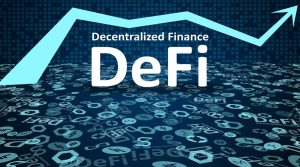In recent years, the world of finance has witnessed a significant transformation with the emergence of decentralized finance (DeFi). DeFi has introduced a new paradigm, offering innovative financial solutions that operate on blockchain networks and are not subject to traditional intermediaries. However, despite the rapid growth and adoption of DeFi, there remains a gap between traditional financial systems and decentralized finance. This article aims to explore the potential of cross-chain bridges in bridging the gap between these two worlds, enabling the seamless integration of traditional finance with the opportunities offered by DeFi.
Introduction
The financial landscape has long been dominated by traditional finance systems, where centralized institutions act as intermediaries in various financial transactions. However, with the advent of blockchain technology, a new ecosystem known as decentralized finance, or DeFi, has emerged. DeFi offers a decentralized alternative to traditional finance, leveraging the power of blockchain networks to provide open, transparent, and permissionless financial services.
While DeFi has gained significant traction in recent years, it still operates largely independently from traditional financial systems. This separation creates barriers for individuals and institutions looking to leverage the benefits of both worlds. Cross-chain bridges have the potential to bridge this gap, allowing assets and data to flow seamlessly between traditional finance and DeFi.
Understanding Traditional Finance
Traditional finance refers to the conventional financial systems that have been in place for centuries. It encompasses banks, insurance companies, investment firms, and other intermediaries that facilitate financial transactions. Traditional finance systems rely on centralized authorities and established regulations to ensure stability and security.
Introduction to Decentralized Finance (DeFi)
Decentralized finance, or DeFi, represents a paradigm shift in the financial industry. It leverages blockchain technology to provide financial services without relying on centralized intermediaries. Key principles of DeFi include transparency, open access, and programmability through smart contracts.
The Gap between Traditional Finance and DeFi
Despite the potential of DeFi, there are several challenges that hinder its integration with traditional finance. Firstly, traditional finance systems operate on different infrastructure and technology compared to DeFi platforms. This disparity makes it difficult to establish direct communication and interoperability between the two ecosystems.
Additionally, regulatory and compliance concerns pose significant challenges. Traditional finance is heavily regulated, with strict Know Your Customer (KYC) and Anti-Money Laundering (AML) requirements. DeFi, on the other hand, operates in a more permissionless and pseudonymous environment, making compliance with traditional regulations a complex task.
Cross-Chain Bridges: An Overview
Cross-chain bridges are technological solutions that facilitate the transfer of assets and data between different blockchain networks. These bridges enable interoperability by creating a connection between separate chains, allowing assets to be transferred from one chain to another.
Cross-chain bridges can operate in various ways, including the use of wrapped tokens, sidechains, or bridges that facilitate direct transfers between different blockchains. These bridges ensure that assets can flow seamlessly between traditional finance systems and DeFi platforms, unlocking new possibilities for users.

Benefits of Cross-Chain Bridges
Cross-chain bridges offer numerous advantages for both traditional finance and DeFi ecosystems. Firstly, they enhance liquidity and asset interoperability. By connecting different chains, cross-chain bridges enable the transfer of assets across various platforms, increasing liquidity and expanding investment opportunities.
Moreover, cross-chain bridges provide risk diversification and mitigation. Users can access a broader range of assets and investment options, reducing exposure to single-chain risks. This diversification contributes to the overall resilience and stability of the financial ecosystem.
Additionally, cross-chain bridges open up new investment opportunities. Traditional financial instruments and assets can be tokenized and made available on DeFi platforms, enabling investors to access new markets and participate in innovative financial products and services.
Challenges and Limitations
While cross-chain bridges offer immense potential, there are several challenges and limitations that need to be addressed. Security and trust concerns arise when assets move between different chains, as each chain may have varying levels of security protocols. Ensuring the integrity and safety of assets during the transfer process is crucial.
Scalability and transaction speeds are also important considerations. As more assets and users utilize cross-chain bridges, the demand for efficient and fast transactions increases. Overcoming scalability limitations and ensuring high transaction speeds are crucial for seamless integration between traditional finance and DeFi.
- Security concerns: Ensuring the security and trustworthiness of assets during the transfer process is crucial. Each blockchain network may have different security protocols, making it challenging to maintain the integrity and safety of assets as they move between chains.
- Scalability and transaction speeds: As the usage of cross-chain bridges increases, there is a need to address scalability limitations. Efficient and fast transaction speeds are essential to enable seamless integration between traditional finance and DeFi ecosystems.
- Regulatory considerations: Cross-chain bridges must comply with the regulatory requirements of both traditional finance and DeFi environments. Striking a balance between innovation and regulatory compliance is crucial to foster widespread adoption and ensure legal compliance.
- Interoperability challenges: Different blockchain networks may have varying technical standards, protocols, and consensus mechanisms. Achieving interoperability between these networks through cross-chain bridges requires addressing technical complexities and achieving seamless compatibility.
- User experience: Providing a user-friendly and intuitive interface for users to interact with cross-chain bridges is vital. The process of transferring assets between different chains should be simplified and accessible to non-technical users, promoting adoption and usability.
- Governance and consensus: The decentralized nature of blockchain networks introduces challenges in establishing governance and consensus mechanisms for cross-chain bridges. Effective governance models and consensus mechanisms need to be developed to ensure the smooth functioning and decision-making of cross-chain operations.
- Regulatory uncertainty: The evolving regulatory landscape surrounding cryptocurrencies, blockchain, and DeFi introduces uncertainty for cross-chain bridges. Clear and favorable regulations are necessary to encourage the integration of traditional finance and DeFi through cross-chain bridges.
- Adoption and awareness: Despite the potential of cross-chain bridges, widespread adoption and awareness are still limited. Educating users and financial institutions about the benefits and functionality of cross-chain bridges is essential to drive their adoption and unlock their full potential.
- Technical complexity: Developing and maintaining cross-chain bridges involves intricate technical processes and requires expertise in multiple blockchain networks. Overcoming technical complexities and ensuring interoperability is a challenge that needs to be addressed.
- Audit and compliance: Auditing and ensuring compliance with cross-chain bridge operations and transactions is essential for maintaining transparency and trust. Establishing robust auditing processes and compliance standards is crucial to mitigate risks and regulatory concerns.
It is important to address these challenges and limitations to foster the successful integration of traditional finance with DeFi through cross-chain bridges.
Furthermore, regulatory considerations play a vital role. Cross-chain bridges must comply with the regulations and requirements of both traditional finance and DeFi environments. Striking a balance between innovation and regulatory compliance is essential to foster widespread adoption.
Real-World Examples of Cross-Chain Bridges
Several blockchain projects are already pioneering cross-chain bridge technology. Polkadot, for instance, aims to create a decentralized ecosystem where different blockchains can communicate and share data. Cosmos focuses on creating an internet of blockchains, enabling interoperability between various chains. Avalanche implements a unique consensus mechanism that allows for rapid and secure transfers of assets between chains.
Potential Impact on Traditional Finance
The integration of cross-chain bridges has the potential to revolutionize traditional finance. By reducing the number of intermediaries involved in transactions, cross-chain bridges can significantly lower costs and increase efficiency. Furthermore, cross-chain bridges can foster financial inclusion by enabling access to DeFi services for individuals who are currently underserved by traditional financial systems.
Moreover, the integration of traditional finance with DeFi through cross-chain bridges encourages innovation in financial products and services. Traditional financial institutions can leverage the benefits of DeFi to create new, customer-centric solutions that enhance user experience and provide novel investment opportunities.
Future Outlook and Conclusion
As blockchain technology continues to advance, the potential of cross-chain bridges in bridging traditional finance with DeFi becomes increasingly promising. The integration of these two worlds has the potential to reshape the financial landscape, offering enhanced efficiency, accessibility, and innovation.
However, it is important to address the challenges and limitations associated with cross-chain bridges, such as security, scalability, and regulatory compliance. By doing so, we can ensure the seamless integration of traditional finance and DeFi, unlocking the full potential of decentralized finance for individuals and institutions alike.
FAQs
Q1: How do cross-chain bridges work? Cross-chain bridges facilitate the transfer of assets and data between different blockchain networks by creating a connection or interoperability layer. This allows assets to be transferred from one chain to another, enabling seamless integration between traditional finance and DeFi platforms.
Q2: What are the benefits of cross-chain bridges? Cross-chain bridges enhance liquidity and asset interoperability, provide risk diversification, and offer access to new investment opportunities. They enable the transfer of assets between traditional finance and DeFi ecosystems, expanding the range of available financial products and services.
Q3: Are there any security concerns with cross-chain bridges? Security is a crucial consideration when utilizing cross-chain bridges. As assets move between different chains, each with its security protocols, ensuring the integrity and safety of assets during the transfer process is paramount. Implementing robust security measures and auditing protocols is essential.
Q4: How can cross-chain bridges impact traditional finance? Cross-chain bridges can reduce the number of intermediaries involved in transactions, resulting in lower costs and increased efficiency. They also promote financial inclusion by providing access to DeFi services for underserved individuals. Additionally, cross-chain bridges encourage innovation in financial products and services.
Q5: What is the future outlook for cross-chain bridges? As blockchain technology advances, cross-chain bridges are expected to play a pivotal role in bridging the gap between traditional finance and DeFi. The integration of these two worlds has the potential to revolutionize the financial industry, offering improved accessibility, efficiency, and innovation.






